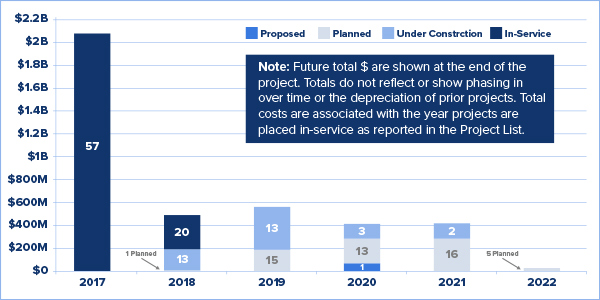ISO-NE staff made few changes to the Regional System Plan in October, although nearly $30 million were cut from the estimate for the Greater Hartford project in Connecticut by revising a 3.7-mile all-underground 115-kV line to a hybrid overhead/underground line, Director of Transmission Planning Brent Oberlin told the Planning Advisory Committee in an update Wednesday.
The RTO reported a $12 million increase in the estimated cost for the Southeast Massachusetts/Rhode Island Reliability Project, reducing the total for all projects in the plan by $18 million since the last update in June to an aggregated estimate of $1.589 billion, Oberlin said.
The cost estimate increased because of two new projects: the West Medway 345-kV circuit breaker upgrades and Medway 115-kV circuit breaker replacements.
Twelve upgrades on the project list have been placed in service since the June 2018 update: four in southwest Connecticut; three around Hartford; and in Massachusetts, a partial rebuild of the 1779 line, a double-circuit tower separation in the Greater Boston area, a reconductor/upgrade on the 112 line, and refurbishment of the Sandy Pond Substation, along with a control house rebuild.
Three new asset condition projects are the Canal Station Project and Robinson Avenue Station Upgrades in Massachusetts, and the Railroad Corridor Transmission Line Asset Condition Upgrades in Connecticut.
Avangrid’s railroad project is the most expensive of the three at $376.3 million, “where they’re essentially getting off the catenary structures that run along the Metro North railroad corridor and moving onto separate poles,” Oberlin said.
Eversource 115-kV Structure Replacements
John Case of Eversource Energy reported the utility’s work replacing aging transmission towers in Connecticut, Massachusetts and New Hampshire.
The utility is replacing 1,585 structures, or about a third of the 4,400 structures inspected, Case said. Eversource maintains more than 20,000 115-kV structures, about two-thirds of them made of wood.
Connecticut accounts for 63%, or $245.4 million, of the $387.6 million total to be spent on the 2018/19 replacements, which cover about 10% of Eversource’s 115-kV infrastructure in the region.
The utility inspects mainly with foot patrols by experienced linemen and high-resolution aerial surveys from helicopters, but a new drone program started last year should be able to survey the whole system within three years, Case said.
Eversource manages approximately 4,000 circuit miles of overhead lines, including around 3,400 structure miles, or nearly 40% of all transmission in New England. The difference between circuit miles and structure miles arises because some structures carry multiple lines, Case said. Their working number is approximately 10 structures to the mile.
Asked whether the spate of storms last March indicated a cost savings to be achieved by putting lines underground, Case said “overheading continues to be an economical and reliable solution to most of our requirements.”
Eastern Interconnection Planning Collaborative on Track
Richard V. Kowalski, ISO-NE system planning technical director, reported that transmission planning in the Eastern Interconnection is well-coordinated among its planning authorities, ensuring NERC reliability requirements are met, according to a report released earlier this month by the Eastern Interconnection Planning Collaborative (EIPC). (See EIPC Finds Eastern Tx Planning Working Well.)
Entities currently participating in EIPC represent approximately 95% of the Eastern Interconnection load. The biggest nonparticipants are Ontario and the Maritimes provinces in Canada.
EIPC has completed an Eastern Interconnection frequency response analysis to support NERC concerns regarding the changing resource mix. ERCOT is already facing operational issues associated with the trend toward an increasing share of renewable resources generating power, he said.
Kowalski explained that one of the bigger concerns with the change in inertial behavior associated with renewable resource technologies is the increased risk of under-frequency load shedding when it shouldn’t happen.
EIPC members share costs on a net energy per load basis, and ISO-NE is not even 5% of the interconnection in terms of net energy per load, Kowalski said.
“ISO-NE’s share this year would have been around $40,000, but we’ve been so far under budget that it should be less,” he said. The only EIPC staff is a consultant serving as executive director.
— Michael Kuser




